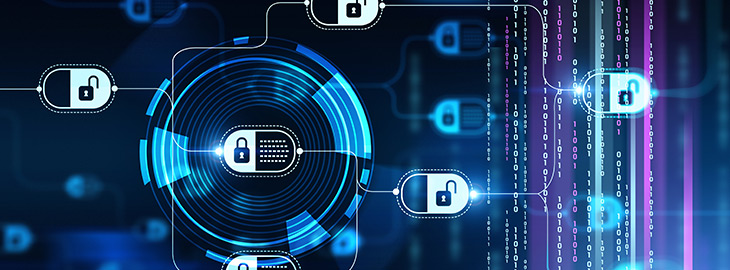
As cyber threats and data breaches proliferate, organizations need a better way to protect their sensitive data. One specific need: effective and efficient data security models.
A security model includes procedures to validate security policies and to implement vital business processes and workflows in your security program. A security model also specifies the data structures and techniques required to enforce security policies.
Several such security models are now available, including the Bell-LaPadula Model, the Biba Model, the Clark Wilson Model, and the Harrison-Ruzzo-Ullman Model.
Why do models matter? Because the traditional approach of application-centric architecture is framed in terms of business processes and workflows, with specific data sources enabling particular functions.
This approach, however, ends up creating silos of data, and also leads to inconsistencies and redundancies that make it harder to safeguard data and assure compliance across the entire enterprise — which is what the enterprise needs these days, since secure, compliant access to data is what drives business performance.
To overcome these limitations and better protect their data, organizations need a data-centric approach to security.
What Is a Data-Centric Architecture?
In a data-centric architecture (sometimes known as a data-centered architecture or simply data centricity), applications are considered transitory. Data is the primary asset, and the data model precedes application implementation.
A data-centric architecture is not the same as a data-driven architecture. A data-driven organization acquires, ingests, and analyzes large volumes of data. More often than not, however, different datasets have different data models, which all exist within a single data lake.
There is little or no effort to harmonize these models. So as the number of data sources and types increases, inconsistency in format, structure, and security becomes a big problem in the data lake.
In a data-centric architecture, all data in the data lake is cataloged for easier analysis. Moreover, there is a predefined architecture as well as standardized model templates, where applications are developed around data instead of the other way around.
What Is Data-Centric Security?
A data-centric approach to security allows organizations to better protect their enterprise information from unauthorized access, theft, compromise, or misuse.
Most legacy security technologies focus on where data is, such as on which endpoint, server, or network. The main drawback of this approach is that if the information moves, it is often left unprotected.
Data-centric security focuses on what needs to be protected rather than where the data actually is. It identifies sensitive data and applies policy-based protection to secure that information throughout the data lifecycle, regardless of its location.
Typically, data-centric security models leverage software agents installed on IT assets where sensitive data is created or stored.
The agents are managed and controlled from a centralized data management console, where the appropriate level of security is defined for each data type and use case.
Benefits of a Data-Centric Approach to Security
The study Making Your Business Cyber-Resilient In 2021 found that most organizations struggle to manage and mitigate cyber risks while keeping the business running.
Part of this is due to the COVID-19 pandemic, which not only changed how organizations work; it also created new threat opportunities for bad actors to attack organizations and their assets. In this landscape, legacy security technologies that focus on protecting data by location are no longer effective or adequate.
In the coming years, data volumes will continue to grow, IT architectures will move further away from traditional network-based models, and perimeter breaches will become even more common.
Data-centric security will become critical to protect organizations from evolving cyber threats and sophisticated threat actors. This paradigm emphasizes more robust data security controls, endpoint security, and identity and access management to deliver the following benefits:
More Reliable Data Protection
Every time a new data file is created or an existing file is modified, the data-centric security system automatically scans it to determine whether the file contains sensitive data. If the file does, the security system automatically applies the appropriate policy-based protection.
End-users are not involved in the process, minimizing the potential for error while maximizing data protection.
Access Only for Authorized Users
In data-centric security, a zero-trust approach is preferred. Based on the principle of least privilege, only authorized users can access protected data, which keeps unauthorized users out and reduces the possibility of a data breach.
Strong Cyber-resiliency
A data-centered architecture empowers organizations to better prepare for, respond to, and recover from cyber threats.
In the post-pandemic world, where organizations experience more frequent and more serious cyber threats, they need a way to remove data silos and continually protect their data, even if other networks and device protections fail.
Data-centric security provides such a method. Organizations can also build “crisis shock absorbers” to maintain business continuity and assure disaster recovery.
Such cyber-resilience enables businesses to reduce risk, protect revenues, and accelerate digital transformation to boost enterprise competitiveness and growth.
Key Components of a Data-Centric Security Architecture
In general, successful implementations of data-centric security consists of these components:
Policy-Based Protection
Data-centric security leverages policies to protect all kinds of data automatically from unauthorized users and threat actors, to prevent data breaches, and to assure that security awareness is embedded throughout the organization.
Centralized Management and Agents
Centralized management is critical to assure consistent and reliable data protection. It ensures that all data is protected according to security policies and remains available to authorized users whenever required.
It also enables the organization to retain complete control over data throughout the data lifecycle, from the moment a file or database record is created.
Agents installed on the IT assets monitor file activity, communicate with the management console to receive policy updates, and provide data for logging and monitoring.
Gapless Protection
When data moves among platforms, devices, or networks, it gets decrypted and is often stripped of protection.
Network- and device-centric security strategies cannot help in such cases, leaving gaps that increase the risk of exploitation by hackers and malicious insiders. Data-centric security eliminates such security gaps.
It offers continuous protection and cross-platform operability to protect sensitive data wherever it’s stored and shared.
Data Discovery and Automation
Automated workflows are vital to data-centric security, allowing employees to do their jobs seamlessly without jeopardizing the organization’s data.
Automation continuously monitors file activity and assures that all security policies are applied in real-time across the enterprise data ecosystem without delays or gaps.
Integration
The best data-centric security solutions integrate with other elements of the organization’s IT infrastructure, including ERP systems, proprietary applications, and productivity tools, to manage and secure all sensitive data appropriately.
Auditing and Reporting
To detect emerging threats and assure compliance with regulatory mandates, auditing and reporting are essential. All data-related activities are logged and reported, adding a layer of security and control.
Usually, the management console provides detailed reports about the location of sensitive data and who can access it.
How ZenGRC Helps Businesses with Data Security
A data-centric model improves enterprise-wide visibility into given applications, tools, and devices. It also consistently and automatically protects sensitive data, minimizing the probability of a data breach and its associated financial, regulatory, and reputational burdens.
To do all this, a robust data-centric security platform like ZenGRC is business-critical.
ZenGRC simplifies security, compliance, audit, risk, governance, and policy management through a single, comprehensive platform.
It reveals risks to information systems across the enterprise, shows where risk is changing, and provides the tools necessary to quickly address critical threats to data, no matter where it resides.
With ZenGRC, your organization can effectively protect its data from internal and external threats and meet all compliance goals.
Contact Reciprocity to learn more about the ZenGRC platform.




